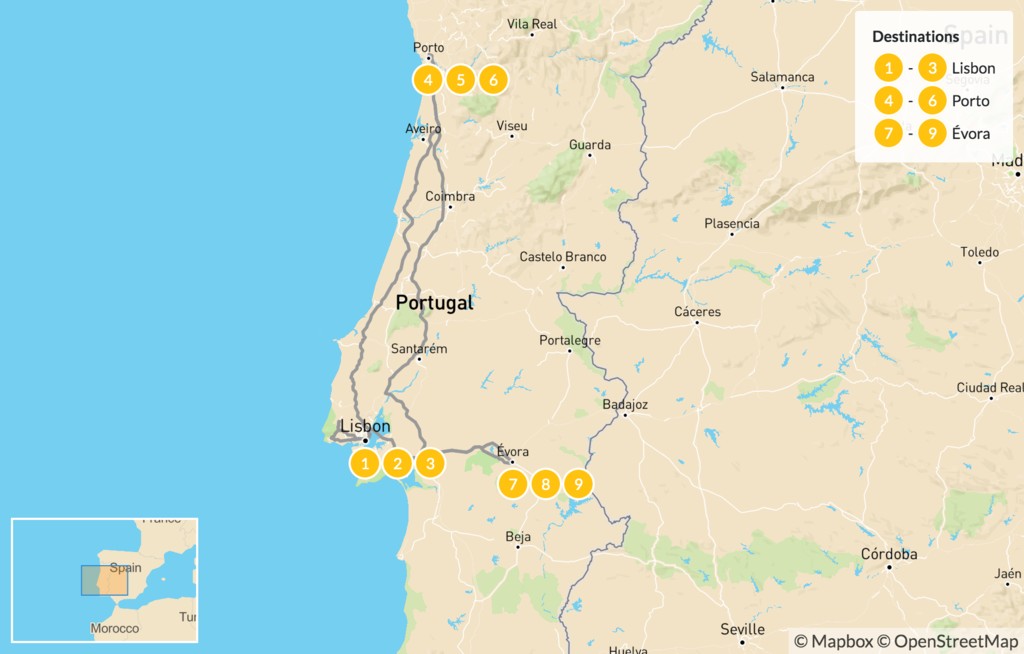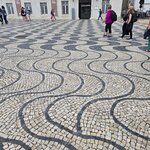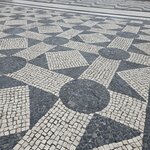Highlights
- Ditch your car for an evening gastronomy tour (by foot) in Lisbon's cobbled streets
- Take a day trip to the fairy tale village of Sintra, surrounded by forested hills
- Make a detour in Óbidos and walk through a centuries-old castle
- Check out hiking/biking trails and 18th-century vineyards in northern Portugal
- Spend three nights in the inner-walled and lively university town of Évora
Brief Itinerary
| Day | Highlights | Overnight |
|---|---|---|
| Day 1 | Arrive in Lisbon, Foodie Walking Tour | Lisbon |
| Day 2 | Half-Day Tour of Lisbon | Lisbon |
| Day 3 | Day Trip to Sintra, Cascais & Estoril | Lisbon |
| Day 4 | Pick Up Rental Car, Drive to Porto via Óbidos | Porto |
| Day 5 | Half-Day Tour of Porto, Evening Food Tour | Porto |
| Day 6 | Explore Porto & Northern Portugal | Porto |
| Day 7 | Drive to Évora, Private Tour | Évora |
| Days 8-9 | Explore Évora & the Alentejo Region | Évora |
| Day 10 | Return to Lisbon, Depart |
Detailed Itinerary
Day 1: Arrive in Lisbon, Foodie Walking Tour

Welcome to Portugal! Upon arrival at Lisbon's airport, you will exit the arrival hall and make your way to the car rental area to pick up your car. Once you arrive at your hotel, there will be some free time to rest after the journey.
When evening hits, you'll take part in a gourmet food tour in Lisbon—a great way to experience the city for the first time! Wear a good pair of walking shoes because you, along with your English-speaking guide, will meander through a series of authentic winding alleys tasting the incredible flavors of Portuguese gastronomy, especially in the neighborhood of Campo de Ourique—practically a city within the city—that sets the food culture and gastronomic trends of Lisbon.
Over the course of four hours, you will visit seven spots that brilliantly link tradition with modernity. Experience ways that locals have reinvented restaurant concepts, including a market and hotel school, while getting a taste of culinary recipes that have become world-famous.
Day 2: Half-Day Tour of Lisbon

Today you'll discover Lisbon on a half-day tour visiting key sites and some well-kept secrets, exposing the city's unique atmosphere and authenticity. This will be a fun adventure as you travel around the city utilizing the yellow tram system broken up with relaxed strolls. Make sure to wear a good pair of walking shoes.
The tour includes the following:
- Praça do Comércio: the largest of Lisbon’s plazas
- Baixa: the 'new city,' built after the devastating 1755 earthquake
- Praça da Figueira: Lisbon’s traditional market square
- Rossio: the heart of downtown Lisbon
- Iron Lift Viewpoint: a stellar 360º view over the downtown district
- Largo do Carmo: the setting for the democratic revolution of 1974
- Carmo ruins: the only Gothic monument of the city
- St. Roque Church: a Baroque extravaganza
- Bairro Alto: the lively bohemian district
- Chiado: the city's most elegant shopping area
- Portas do Sol: a breathtaking view over Alfama (the Old Town)
In the evening, you'll dine at one of the best Fado restaurants in Lisbon for traditional Portuguese cuisine interspersed with authentic singing and music.
Day 3: Day Trip to Sintra, Cascais & Estoril

The area surrounding Lisbon offers an incredible variety of architecture and scenery, from fairy tale palaces to romantic towns and breathtaking viewpoints. Today's guided excursion is the ideal way to experience some of these attractions.
After breakfast at your hotel, your guide will deliver you to the first stop on the tour: Sintra. This village—about 30 minutes by car from the capital—is a harmonic combination of history and fantasy, described as a "glorious Eden" by the British poet Lord Byron in the 18th century. You will have free time to explore on your own and have lunch, and your guide can recommend some imposing monuments and wonderful palaces worth visiting.
Your next stop will be the Cabo da Roca, the westernmost point of Portugal and mainland Europe. Enjoy the gorgeous views across the Atlantic Ocean as waves crash onto the shore. On the return trip to Lisbon, you will have time to appreciate the fishing harbor and tourist center of Cascais, the former summer residence of the Portuguese royal family and an excellent spot for surfing nowadays. You'll also be able to visit the luxury entertainment town of Estoril, known for its casino (the largest in Europe) and attractive gardens.
After the excursion, you'll have the remainder of the day to enjoy Lisboin however you'd like.
Chat with a local specialist who can help organize your trip.
Day 4: Pick Up Rental Car, Drive to Porto via Óbidos

After breakfast at your hotel, it's time to make the journey to Porto, Portugal's second-largest city. It won't be a direct route, though: About halfway through the drive, you'll make a morning stop in the charming walled city of Obidos. The historic center here offers a labyrinth of narrow cobblestoned streets and flower-bedecked, whitewashed houses, livened up with dashes of vivid yellow and blue paint.
Historically, Óbidos was recaptured from the Moors and presented to the Queen of Portugal on her wedding day—not once, but a long-lasting tradition that began with Queen Urraca in 1214 and continued until the 19th century. You'll have time to enjoy a self-guided tour around the village, including its stunning centuries-old castle.
Following lunch, continue driving the rest of the way to Porto, where you'll have the rest of the day to relax and explore the city streets on your own.
Day 5: Half-Day Tour of Porto, Evening Food Tour

Today is a great introduction to Porto! After breakfast at the hotel, you'll join a half-day tour of the city with a local guide. This excursion will lead you through the most important landmarks of Portugal's second-most populous city as you travel from place to place in a comfortable private vehicle.
Your guide will explain the rich history of this city, also called Invicta (the Unbeaten City), with stories of heroes and battles as you make your way to the trendiest and most cultural area of the city. Here you'll explore Boavista Avenue, one of the city's most important streets, and Foz, home to some of the most important museums and modern local treasures.
Next, you'll head to the city center—a UNESCO World Heritage Site—to admire the most renowned Romanesque, Gothic, Baroque, and neoclassical monuments and sites, including the São Bento Railway Station, Clerigos Tower, Church of St. Francis, Lello Bookshop, Sta. Catarina Street, Majestic Café, and Bolhão Market, to name a few. After visiting the imposing Porto Cathedral with its superb silver altarpiece, you will finish the tour along the banks of the immense Douro River with views of Ribeira Plaza and the Dom Luís I Bridge.
But that's not all: In the evening (after some time to rest), it's time for another tour—this time centered on the city's exciting food scene. This is your chance to get off the well-worn tourist path for a side of Porto that travelers rarely see. You'll be welcomed by local families in their small, authentic restaurants, cafés, and bars as you taste a range of traditional dishes, local pastries, and, of course, Portuguese wines.
Day 6: Explore Porto & Northern Portugal

After breakfast in Porto, you will have a free day to explore more of the city on your own. You can also take a day trip in Northern Portugal, whether hiking, hitting the beach, wine tasting, or visiting some noteworthy towns and historical sites. Some recommendations include:
- Braga: Check out this café-filled center, where students from the nearby university meet to socialize and discuss ideas. Meanwhile, a short distance away is the famous Bom Jesus do Monte (Bom Jesus Sanctuary) and the oldest cathedral in the country.
- Aveiro: Nicknamed the 'Venice of Portugal,' Aveiro's charming canals are quieter and arguably more colorful than the Italian city, with brightly painted boats and buildings. The town is an easy jaunt from Porto, whether you choose to drive, take a train, or hop on a bus.
- Guimarães: History buffs shouldn't leave northern Portugal without seeing where the country's origins began. The royal family lived in the home of Portugal's first king, Guimarães Castle, but there are plenty more medieval structures where that came from.
- Esposende: Just a quick, half-hour drive away, Esposende offers white sand beaches and picturesque dunes for a relaxing retreat—especially if you need to soak up the sun and catch up on literature.
- Viana do Castelo: A little farther north of Esposende is this larger beach town—listed as one of the more visually appealing cities in Portugal with a medieval center. As a fishing port, it's also an excellent spot for devouring seafood.
- Peneda-Gerês National Park: Take a trek or mountain bike ride through Portugal's only national park for some physical activity. Located in Viana do Castelo and Braga districts, it's an easy place to add to your itinerary.
- Vigo: One of the cooler things that comes with a visit to northern Portugal is its proximity to Spain. Rich in culture and often overlooked, Vigo is considered one of the larger fishing ports in the world and a great place to indulge in fish and seafood.
Day 7: Drive to Évora, Private Tour

This morning, after breakfast at your hotel, you'll get on the road and head to the town of Évora—a driving distance of about three hours.
After lunch in town, you will begin a private guided tour to discover the most impressive treasures of this UNESCO-listed city (awarded in 1986). While answering questions along the way, your guide will cover Évora's main monuments, including those pertaining to the golden age of Portuguese maritime discoveries. This tour is especially ideal for visitors wishing to get an overview of the city's major events, which have always been linked to the most significant moments in Portugal's history.
In the evening, you'll have the free time to explore Évora's streets and dining scene on your own.
Days 8-9: Explore Évora & the Alentejo Region

After breakfast at your hotel, you'll have the entire day to explore more of Évora at your own pace—a small city blessed with a large number of national monuments inside its ancient Moorish walls.
Alternatively, you could get in a car and drive around the surrounding Alentejo region, Portugal's biggest, which covers about 30% of the country. The sparsely populated yet vast swath of land between the Algarve region and Lisbon offers scenic rolling hills, olive groves, vineyards, and charming fortified towns with a number of walking trails, Neolithic monuments, rustic wineries, and cork production facilities.
No matter how you spend your day, enjoy the slow pace of life; residents in the Alentejo region are more traditional than other parts of Portugal, reflected in their homecooked cuisine and local handicrafts.
Day 10: Return to Lisbon, Depart

It's time to say goodbye to Portugal! At the designated time, you'll make the return drive to Lisbon's airport, return your rental car, and prepare for your departure home. Safe travels!
More Great Portugal Itineraries
Looking for more inspiration for your trip to Portugal? Check out these other Portugal itineraries, explore different ways to spend 10 days in Portugal, or discover the best time to visit Portugal.








